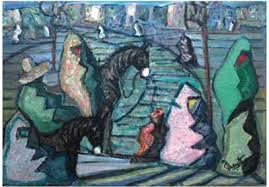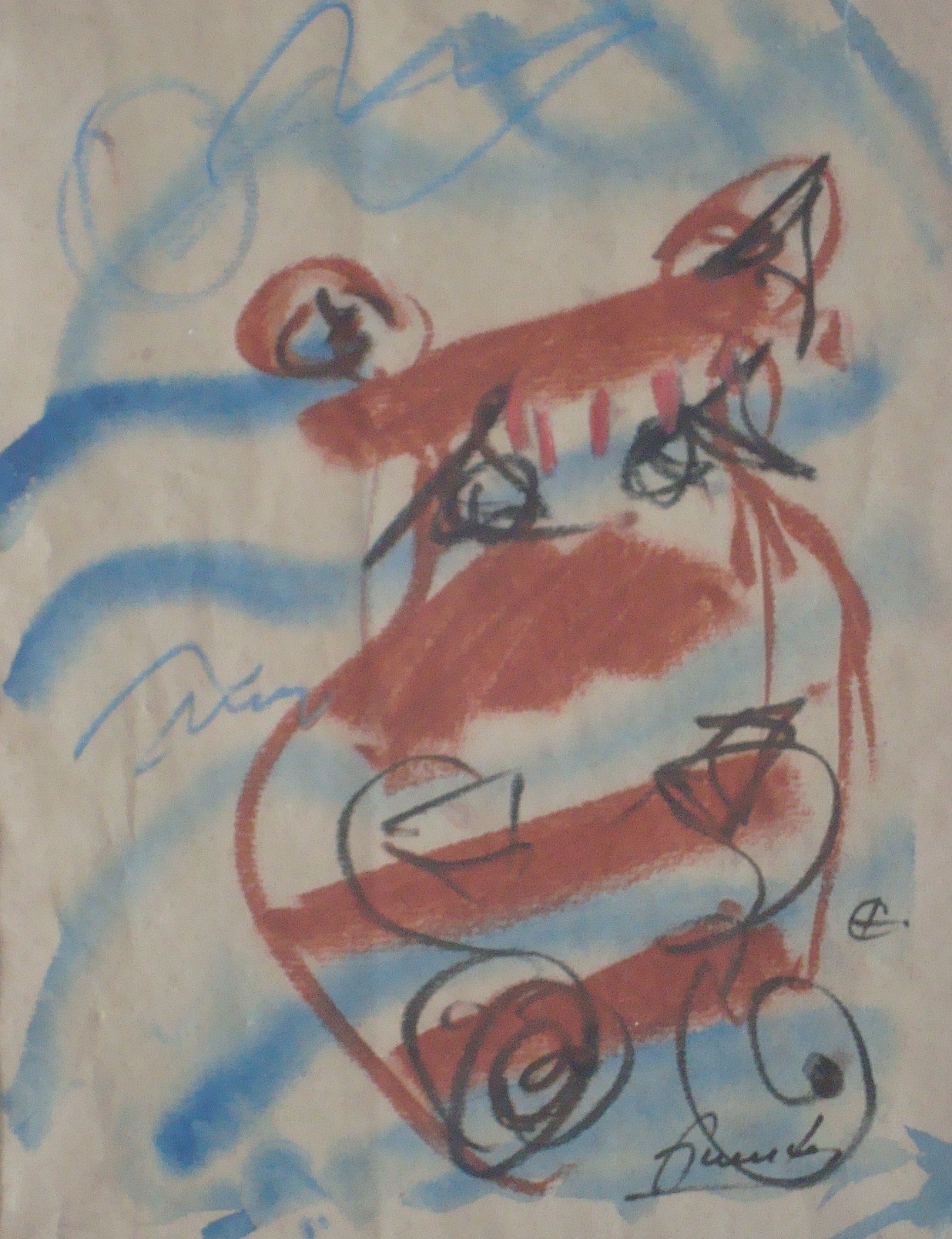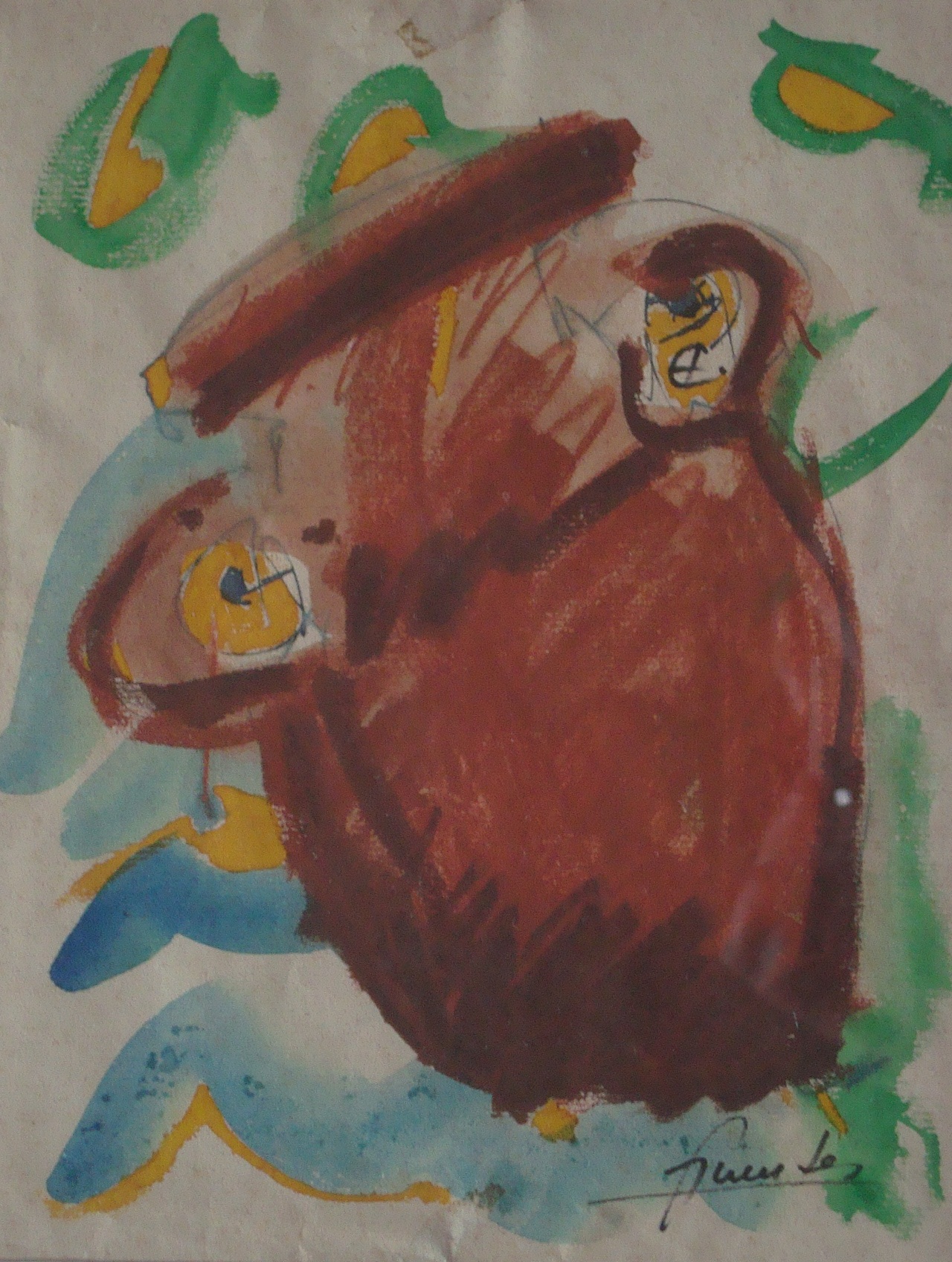In “Hotel Fuentes” on 9th October 1905, Antonio Fuentes was born, in the same hotel where Camille Saint – Saëns composed “Danza Macabra”. In the same “Zoco Chico”(small Moroccan market) where Delacroix, Fortuny, Tapiró, Van Rysselberghe, Iturrino, Matisse… painted
As a child Antonio Fuentes painted on the marble tables at the Fuentes café. At thirteen he did drawings for “El Heraldo de Marruecos” (A Moroccan newspaper). At fourteen, pictures for “La Esfera” and “El Nuevo Mundo”. Without knowing, he was becoming the “Toulouse-Lautrec” of Tangiers and this was mentioned years later by the great French hispanist Pierre Gassier. Encouraged by the Spanish artists Abascal and Ortiz Echagüe, he decided to dedicate himself exclusively to painting. He drew the world around him in an ironically distorted way.
At fifteen his life revolved around painting. Antonia, a very pretty gypsy that worked in Antonio Fuentes’ mother’s house, until her death in her nineties she had a very close relationship with all of the family, told how Antonio lived an almost isolated life in the top floor rooms of the Fuentes Hotel, where he would spend the day drawing naked. Antonio painted the ceilings of these rooms using the smoke from candles.
Having recently finished military service in Cadiz in 1925, Fuentes went to study in Madrid, where he enrolled at the San Fernando Royal Academy of Fine Art. In this period he drew a beautiful portrait of Federico García-Lorca that has now disappeared but we can see it in some of Fuentes’ photos in his studio. The Academic nature he experienced in Madrid did not impress him so he decided to go to Paris, to Montparnasse. In 1929 he painted day and night in “La Grande Chaumière”, a vast academy that was a ramshackle-a studio where all the great names of contemporary painting had been. Fuentes drew using a paintbrush, and that is how he gained his strength and confidence in the sketch. He became a great artist.
During his stay in Paris he did caricatures for “La Semaine de Paris”. Thanks to these caricatures he met every Spanish artist that went to Paris: Manuel de Falla, Encarnación López – “La Argentinita”, Vicente Escudero, Andrés Segovia. In this period he sketched a series of dancers called the “bailaores” from the Spanish ballet.
At night he met in cafés with other Spanish painters: Souto, Pelayos, Bores. However, as quoted by Emilio Sanz de Soto, “As Fuentes was so immersed in the “Zoco Chico” in Tangiers atmosphere and in daily contact with Arabs and Jews, the painters he was most friendly with were the two following Jews: Möise Kisling and Chaïm Soutine”. He did not agree with the artistic approach of many of his compatriots “they were all obsessed with Picasso-which was normal-but what in Picasso’s art was pure instinct, the people from my town reconverted to intellectual algebra”.
During those years he started to admire Rembrandt; he believed that all new paintings should be based on “The slaughtered Ox”. In 1930 he was accepted at “La Nationale des Beaux Arts” thanks to a superb nude painting. He carried out his first own exhibition at the “Salle d’Art Castelucho”, where he met Picasso. In collective exhibitions he appeared with Kisling and Vlaminck.
In 1934 he moved to Italy to continue his training. He started in Florence, as Felice Carena’s pupil (1879-1965) and later went to Rome, where he enrolled in the Spanish Academy of Fine Art. The original enrolment sheet signed by Valle-Inclán, Academy director, has been kept. He continued collaborating with the Spanish press by sending pictures from Italy.
In Rome he drew a sketch of His Majesty Alfonso XIII, who later signed with the following: “Yes sir, that is me by the grace and misfortune of God”. It was a caricature portrait in the way Fuentes drew in Paris. Terence MacCarthy created: “A Dictionary of Painters in Tangier, 1669 – 2003”, that was dedicated to Fuentes – “the ridden genius” (the most newly advanced of all the contemporary artists) he says the following about this portrait: “Whilst still a student he executed a portrait of the exiled Spanish sovereign, King Alfonso XIII. The portrait was recently sold at auction . It is believed to have been purchased by King Juan Carlos”.
At the end of World War 2, Fuentes returned to Tangiers and he enclosed himself in his house-studio in the old quarter of the city, in the “plaza de los Aissauas”. From then on he rarely exhibited; only when close friends or institutions convinced him to do so. On these occasions great names from artistic and cultural critics would highly rate his exhibitions. A thorough compilation of all the texts about the work and life of Fuentes is being carried out for publication in “www.antoniofuentes.org”.
From 1973 Antonio Fuentes became totally isolated both socially and artistically. He completely devoted himself to meditation and his work focused on abstraction, creating the “frottages” series in 1990 when Fuentes was 85.
Fuentes enjoyed the freedom of being able to dedicate himself exclusively to his work, without having anyone to distract him from it and without having to commercialise it. He would sell in his studio when “the buyer had enough class to have my work”. The buyers had to take a risk to see if Fuentes would welcome them, and if he did, if they managed to buy his work.
In the nineties, the Spanish General Consulate in Tangiers asked him to hold a retrospective exhibition of his work. Fuentes refused to do it. Subsequently they proposed a conversion of his house into a Fuentes Museum, as well as holding a Travelling Retrospective Exhibition with a general cataloguing of his work. The photographic catalogue is made up of more than 450 works of art distributed in important private collections all over the world, from South America, United States and Europe to Saudi Arabia. Fuentes refused both proposals.
In his last few years he reflected on his life – in a quasi-automatic style of writing – all his memories. I was particularly moved by the texts where Fuentes relates to his meetings with Picasso in Paris, 1930 and Vallauris thirty years later.
In the first of those, Fuentes tells how he met Picasso in the artwork supplies shop next to the “Castelucho” gallery and the subsequent visit with the curator of the gallery exhibition. In this visit, Antonio Fuentes suggested to Picasso (to not mutually interfere in the visit) that they go round the exhibition in different directions and on exit discuss the exhibit they thought the best. They both agreed in their evaluation: A gypsy girl painted by Nonell. In this meeting with Picasso, Fuentes also tells us how the owner of the gallery (who had some of his work in the warehouse) offered him a large amount of money for a painting that a client wanted to buy. Fuentes doubted the sale. Picasso told him that he shouldn’t doubt it, that by selling it he would have clientele in Paris. In this series of texts, Fuentes describes Picasso as an old gentleman-Antonio was then twenty five and Picasso fifty-a middle class person, with a good wax jacket and a borsalino hat and whom he treated like a father because of his humble attitude.
In the texts about Vallauris, Fuentes –who had travelled to Venice to exhibit – visited Picasso and they went to a tip together where Picasso used to find objects for his sculptures.
Antonio Fuentes died in Tangiers on 25th July 1995, having worked non-stop. Even in his last few days he got annoyed when people distracted him. He did not allow himself to leave his house-studio in the old quarter of Tangiers- until one day he finally went to the Spanish hospital in Tangiers, where he died one day later. Mª Paz Mateo and Manuel Rodríguez–Ballester, both teachers from the Spanish Institute in Tangiers were his last companions. On 20th July 1995 they went to see him as almost every day. When they offered him a little box of watercolours, he said to them that painting gave him life.
At the commemorative exhibition of Fuentes’ one hundred year birthday, we show series from 1929 to the nineties. The funds from this exhibition all went to his family.
We can see the career of an artist that knows and participates in every moment of the Art development throughout the XX century, but always adjusts each school to its own artistic personality.
A whole century dedicated to creation. When Tangiers lost the International City status, family and friends advised Fuentes to leave, something that Fuentes always refused to do.








Leave a comment :
You must be logged in to post a comment. (Log in)